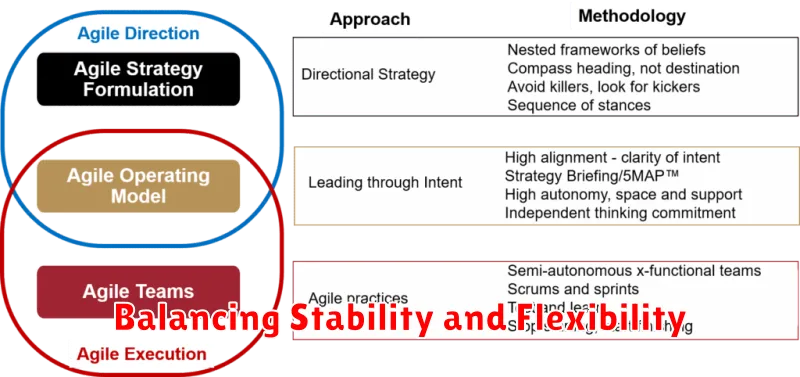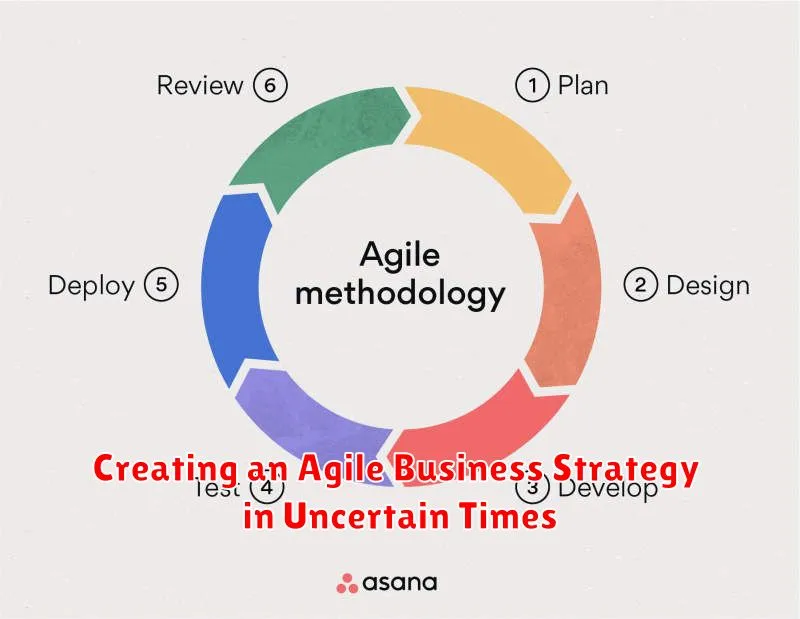In today’s rapidly evolving business landscape, characterized by uncertainty and volatility, traditional strategic planning methods often fall short. A static, long-term approach struggles to adapt to unforeseen market shifts, technological disruptions, and evolving customer demands. This necessitates a shift towards agile business strategy, a dynamic and iterative approach that allows organizations to navigate uncertainty with resilience and seize opportunities for growth. Creating an agile business strategy enables companies to respond effectively to change, fostering innovation and maintaining a competitive edge in unpredictable times.
This article explores the key principles and practices of creating an agile business strategy in the context of uncertain times. We will examine how organizations can develop a flexible and adaptable strategic framework that embraces change, encourages experimentation, and prioritizes customer value. By understanding and implementing the concepts discussed, businesses can enhance their ability to navigate volatility, mitigate risk, and achieve sustainable success in a dynamic and unpredictable world. Learn how to build an agile business strategy that empowers your organization to thrive amidst uncertainty and drive future growth.
Why Agility Matters in Modern Business
In today’s rapidly evolving market, agility is no longer a luxury, but a necessity. Businesses face constant disruptions, from technological advancements to shifting consumer preferences and unforeseen global events. A static, traditional approach simply cannot keep pace.
Agility allows businesses to adapt quickly to these changes, pivoting their strategies and operations to seize new opportunities and mitigate emerging threats. It fosters resilience, enabling organizations to withstand unexpected challenges and emerge stronger. Ultimately, agility empowers businesses to thrive in uncertainty, maintaining a competitive edge in a dynamic landscape.
Principles of Agile Thinking
Agile thinking goes beyond software development. It’s a mindset characterized by flexibility, collaboration, and a focus on iterative progress. This approach is crucial for navigating uncertainty.
Key principles include embracing change, delivering value incrementally, and fostering continuous feedback loops. Teams operating with an agile mindset prioritize customer collaboration over rigid contract negotiation and responding to change over following a set plan. This allows for rapid adaptation to evolving market conditions and customer needs.
Scenario Planning and Forecasting
In uncertain times, traditional forecasting methods often fall short. Scenario planning offers a more robust approach. Instead of predicting a single future, it explores multiple potential outcomes. This allows businesses to develop flexible strategies adaptable to various circumstances.
Begin by identifying key uncertainties impacting your business. Then, develop a few plausible scenarios based on different combinations of these uncertainties. For each scenario, outline potential impacts and define appropriate strategic responses. This process encourages proactive thinking and prepares the organization for a wider range of possibilities.
Rapid Response to Market Shifts

In uncertain times, businesses must be able to react quickly and efficiently to sudden market changes. Agility is key to surviving and thriving in volatile environments. This requires a shift away from traditional, rigid planning cycles toward more dynamic and adaptive strategies.
Real-time data analysis and market monitoring are crucial for identifying emerging trends and potential disruptions. This information empowers businesses to make informed decisions swiftly, adjusting course as needed to capitalize on opportunities or mitigate risks.
Cross-functional collaboration becomes paramount, enabling rapid information sharing and coordinated responses across different departments. This breaks down silos and fosters a more unified and efficient approach to addressing market shifts.
Involving Cross-Functional Teams
A cornerstone of agile business strategy is the utilization of cross-functional teams. These teams bring together individuals with diverse skill sets from various departments, such as marketing, sales, product development, and operations. This collaborative structure fosters a holistic view of the business challenge and promotes innovative solutions.
Cross-functional teams enable faster decision-making and reduced bottlenecks typically associated with traditional hierarchical structures. By bringing together the necessary expertise, these teams can quickly adapt to changing market conditions and customer needs. This agility is essential for navigating uncertain times.
Effective communication is paramount within these teams. Transparency and regular feedback loops ensure alignment and facilitate the rapid iteration central to agile methodology.
Leveraging Technology for Fast Adaptation
In today’s volatile market, technology plays a crucial role in enabling businesses to adapt quickly. Implementing the right technological solutions can empower an organization to respond effectively to unexpected shifts and maintain a competitive edge. This includes investing in tools that enhance data analysis, improve communication, and automate key processes.
Cloud computing offers scalability and flexibility, allowing businesses to adjust resources as needed. Artificial intelligence (AI) and machine learning (ML) can analyze large datasets, providing valuable insights for faster decision-making. Adopting these technologies empowers businesses to remain agile and navigate uncertainty with confidence.
Simplifying Decision-Making Processes
In uncertain times, streamlined decision-making is crucial for an agile business strategy. Overly complex processes can hinder responsiveness and create bottlenecks. Simplifying decisions involves empowering individuals, decentralizing authority, and focusing on key data.
Decentralized decision-making allows teams closest to the information to act quickly. This reduces reliance on lengthy approval chains and fosters a more responsive organization. Empowering employees to make decisions within defined boundaries also increases ownership and engagement.
Prioritizing data-driven decisions is equally important. By focusing on relevant data and minimizing reliance on assumptions, businesses can make more informed choices, reducing the risk of errors and increasing the likelihood of successful outcomes.
Feedback Loops and Iterative Learning
In uncertain times, a rigid, pre-planned strategy can quickly become obsolete. Agile businesses thrive by embracing feedback loops and iterative learning.
This involves establishing short cycles of planning, execution, and review. Data gathering and analysis are crucial throughout each cycle. This data informs adjustments to the strategy, allowing the business to adapt to changing market conditions and customer needs.
This approach fosters continuous improvement and allows for course correction along the way, minimizing risks and maximizing opportunities.
Case Studies of Agile Companies
Examining real-world examples provides valuable insights into successful agile implementation. The following case studies highlight how different companies leveraged agile principles to achieve positive outcomes.
Case Study 1: Spotify
Spotify, the popular music streaming platform, utilizes a squad-based agile framework. These small, cross-functional teams have autonomy and ownership over specific features, enabling rapid iteration and deployment of new functionalities.
Case Study 2: Netflix
Netflix, the streaming giant, embraces a culture of freedom and responsibility. This decentralized approach empowers employees to make decisions quickly, fostering innovation and adaptability in a highly competitive market.
Balancing Stability and Flexibility

In today’s volatile environment, businesses must find the equilibrium between stability and flexibility. Stability provides a solid foundation, built on consistent processes and a clear vision. This foundation ensures operational efficiency and fosters trust among stakeholders.
However, relying solely on stability can lead to rigidity. Flexibility, on the other hand, allows businesses to adapt to changing market conditions, embrace new opportunities, and navigate unforeseen challenges. It involves cultivating a culture of innovation and responsiveness.
The key lies in strategically balancing these two seemingly opposing forces. A business needs the stability of a well-defined core strategy, while simultaneously fostering the flexibility to adapt tactics and execution. This dynamic approach allows organizations to remain resilient and competitive in uncertain times.

